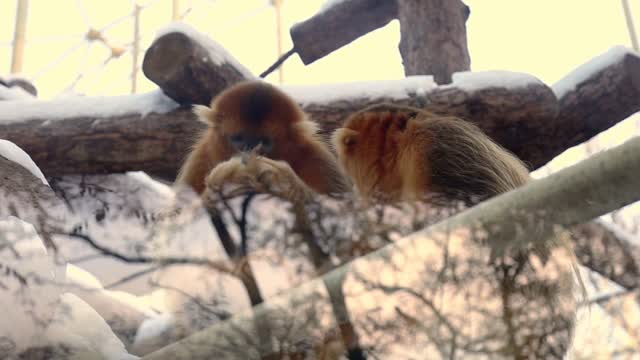Premium Only Content

Twins Adorable Monkeys Communicate With Unknown Language
Scientists have spent years trying to understand monkey communication. They have learned that individual calls may not mean much of anything, but when certain calls are made in a certain order, they can be interpreted. The same sounds that tell monkeys to beware of a leopard in the grass can be rearranged to say that a hungry eagle is nearby. Scientists also believe that when monkeys know each other, they seem to be able to recognize each other's voices.
We all know the expression monkey see, monkey do. But should the saying really go monkey hear, monkey do? Recent studies are finding that the language abilities of some monkeys are more sophisticated than previously believed. Much more sophisticated.
Monkeys live together in social groups. All members contribute by helping to defend food sources, raise young, and watch for predators. But it is impossible to live in a social group without some form of communication. Group members need ways to influence and inform each other.
This is what drives language. Monkeys have evolved many ways of communicating, including visual cues, auditory calls, and even some olfactory signals. Some of their visual signals are quite beautiful, like the long, curled tongue of the emperor tamarin, signaling to her mate when she wants to offload her babies. But visual signals only work if they can be seen.
In the dense forest and underbrush that most primates live in, auditory cues are a much more powerful tool. Calls and vocalizations can also be modified in pitch, loudness, and duration, which means a vast array of messages can be transmitted. Alarm calls, territorial calls, food calls, personal identification calls, dominance calls — these are the basic messages that primates need to successfully live in groups.
But some developed more complex and specialized forms of auditory communication. Some developed language.
No animals have all the aspects of human language, but several species have some. Diana monkeys, seen in Clever Monkeys, are some of the most clever monkeys when it comes to language. They combine calls to make sentence-like messages. This requires grammar. The meaning of the “sentence” depends on what sounds are included and in what order. Added sounds convey more information, like “maybe,” or “not urgent.” Each predator has an assigned call.
The eagle call differs from the jaguar call, meaning Diana monkey language includes semantics: signals convey meaning and refer to features in the real world. And what’s more impressive is that the Diana monkeys can understand other species of monkeys. Putty-nosed guenons also combine calls, and their messages can be understood by the Diana monkeys.
A remarkable example of multilingual primates is seen in Clever Monkeys, with eight different monkey species living together and listening to each other. With eight times as many eyes on the lookout, it’s much harder for predators to go unnoticed. Each of the eight species has at least 15 distinct calls — that’s 120 different sounds to remember. There aren’t many humans that speak eight different languages.
-
 1:36
1:36
Deer In Nature
4 years ago $0.09 earnedCaring mama stops by with her adorable twins
2891 -
 LIVE
LIVE
The Charlie Kirk Show
1 hour agoJUDGMENT DAY 2025: The Election Results Stream
11,443 watching -
 LIVE
LIVE
MattMorseTV
2 hours ago $13.82 earned🔴Election Day LIVE COVERAGE.🔴
2,202 watching -
 LIVE
LIVE
Professor Nez
5 hours ago🚨ELECTION NIGHT 2025 LIVE! Massive Upsets Brewing in New York, New Jersey & Virginia!
70 watching -
 LIVE
LIVE
Due Dissidence
8 hours agoLIVE: ELECTION RESULTS From NYC, NJ, and VA - Trump Approval CRATERS, Kash's Private Jet CRASH OUT
1,284 watching -
 12:50
12:50
Demons Row
1 hour agoBikers of New Jersey 💀🏍️ Pagans, Thunder Guards, and Thug Riders
7 -
 42:31
42:31
Stephen Gardner
4 hours ago🔥Old Obama Video RESURFACES - His Own Words CONDEMNED Him! Trump Gains MASSIVE Momentum!!
5.33K11 -
 LIVE
LIVE
LFA TV
22 hours agoLIVE & BREAKING NEWS! | TUESDAY 11/4/25
639 watching -
 1:03:37
1:03:37
BonginoReport
3 hours agoElection Night Showdown Spotlight - Nightly Scroll w/ Hayley Caronia (Ep.170)
82.8K18 -
 LIVE
LIVE
Edge of Wonder
2 hours agoSupernatural Forces & Giants Built Great Pyramid of Egypt
200 watching